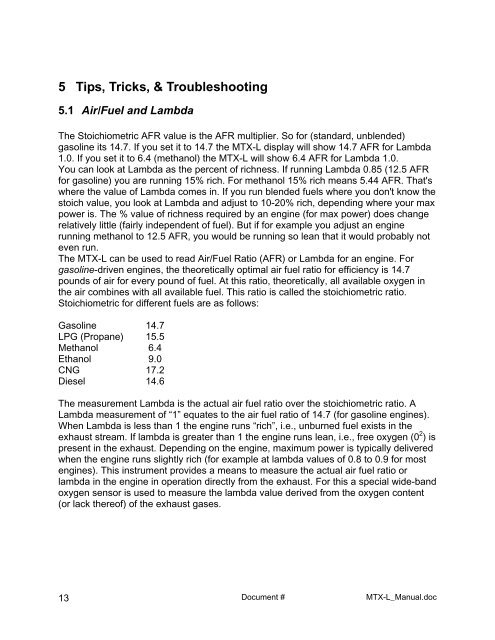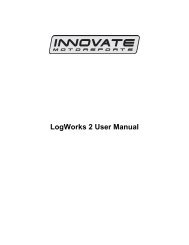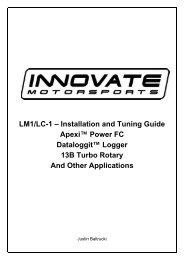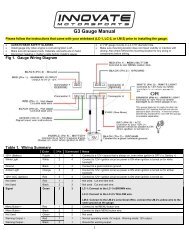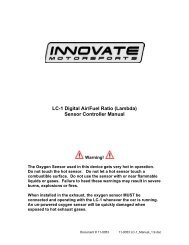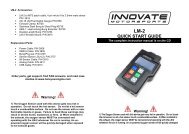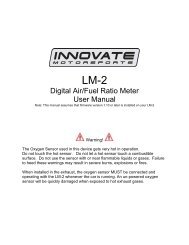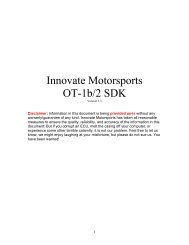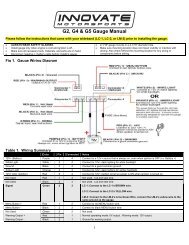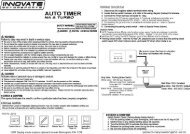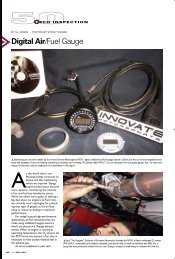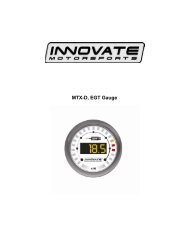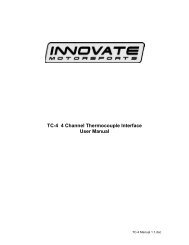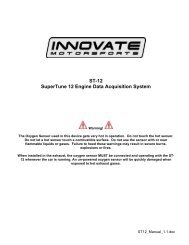Digital Air/Fuel Ratio Gauge User Manual - Innovate Motorsports
Digital Air/Fuel Ratio Gauge User Manual - Innovate Motorsports
Digital Air/Fuel Ratio Gauge User Manual - Innovate Motorsports
Create successful ePaper yourself
Turn your PDF publications into a flip-book with our unique Google optimized e-Paper software.
5 Tips, Tricks, & Troubleshooting<br />
5.1 <strong>Air</strong>/<strong>Fuel</strong> and Lambda<br />
The Stoichiometric AFR value is the AFR multiplier. So for (standard, unblended)<br />
gasoline its 14.7. If you set it to 14.7 the MTX-L display will show 14.7 AFR for Lambda<br />
1.0. If you set it to 6.4 (methanol) the MTX-L will show 6.4 AFR for Lambda 1.0.<br />
You can look at Lambda as the percent of richness. If running Lambda 0.85 (12.5 AFR<br />
for gasoline) you are running 15% rich. For methanol 15% rich means 5.44 AFR. That's<br />
where the value of Lambda comes in. If you run blended fuels where you don't know the<br />
stoich value, you look at Lambda and adjust to 10-20% rich, depending where your max<br />
power is. The % value of richness required by an engine (for max power) does change<br />
relatively little (fairly independent of fuel). But if for example you adjust an engine<br />
running methanol to 12.5 AFR, you would be running so lean that it would probably not<br />
even run.<br />
The MTX-L can be used to read <strong>Air</strong>/<strong>Fuel</strong> <strong>Ratio</strong> (AFR) or Lambda for an engine. For<br />
gasoline-driven engines, the theoretically optimal air fuel ratio for efficiency is 14.7<br />
pounds of air for every pound of fuel. At this ratio, theoretically, all available oxygen in<br />
the air combines with all available fuel. This ratio is called the stoichiometric ratio.<br />
Stoichiometric for different fuels are as follows:<br />
Gasoline 14.7<br />
LPG (Propane) 15.5<br />
Methanol 6.4<br />
Ethanol 9.0<br />
CNG 17.2<br />
Diesel 14.6<br />
The measurement Lambda is the actual air fuel ratio over the stoichiometric ratio. A<br />
Lambda measurement of “1” equates to the air fuel ratio of 14.7 (for gasoline engines).<br />
When Lambda is less than 1 the engine runs “rich”, i.e., unburned fuel exists in the<br />
exhaust stream. If lambda is greater than 1 the engine runs lean, i.e., free oxygen (0 2 ) is<br />
present in the exhaust. Depending on the engine, maximum power is typically delivered<br />
when the engine runs slightly rich (for example at lambda values of 0.8 to 0.9 for most<br />
engines). This instrument provides a means to measure the actual air fuel ratio or<br />
lambda in the engine in operation directly from the exhaust. For this a special wide-band<br />
oxygen sensor is used to measure the lambda value derived from the oxygen content<br />
(or lack thereof) of the exhaust gases.<br />
13<br />
Document #<br />
MTX-L_<strong>Manual</strong>.doc


